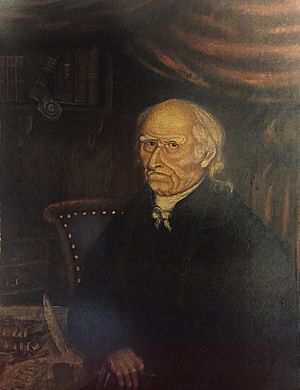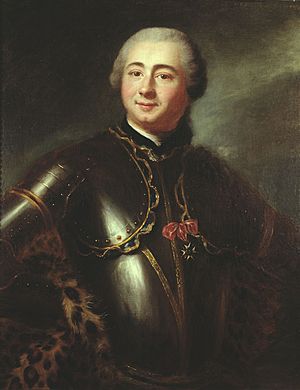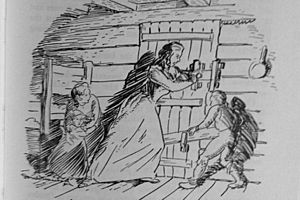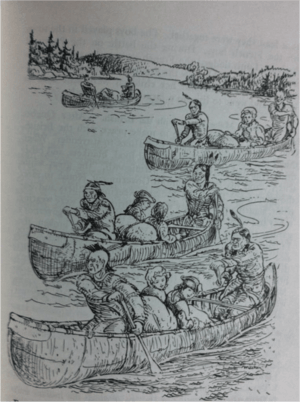Raid on Lunenburg, Nova Scotia (1756) facts for kids
Quick facts for kids Raid on Lunenburg |
|||||||
|---|---|---|---|---|---|---|---|
| Part of the French and Indian War | |||||||
 John Payzant (1749-1834)- taken captive for four years (age 6-10), Perkins House Museum |
|||||||
|
|||||||
| Belligerents | |||||||
Wabanaki Confederacy (Mi'kmaq and Maliseet) |
|||||||
| Commanders and leaders | |||||||
| Lieut-Colonel Patrick Sutherland, Dettlieb Christopher Jessen |
Charles Deschamps de Boishebert | ||||||
| Strength | |||||||
| 30 | unknown | ||||||
| Casualties and losses | |||||||
| disputed – French report: 20 killed, 5 prisoners; British report: 5 killed, 5 prisoners | none | ||||||
The Raid on Lunenburg was an attack that happened during the French and Indian War. On May 8, 1756, Mi'kmaq and Maliseet fighters attacked a British settlement called Lunenburg, Nova Scotia. This settlement was located in what is now Canada.
The attackers targeted two islands near Lunenburg: [John] Rous Island and Payzant Island (which is now called Covey Island). French reports say that twenty settlers lost their lives and five were taken as prisoners. This raid was the first of many attacks that Indigenous groups and Acadians would make on the area over the next three years. Two people, John Payzant and Lewis Payzant, were captured during this raid. They later wrote down their experiences.
Contents
Why the Raid Happened
The French and Indian War was a big conflict between Great Britain and France. Both countries wanted control over land in North America. Indigenous groups often allied with either the French or the British.
Early Conflicts in the Region
Before the French and Indian War, there were other conflicts. For example, during King George's War, Mi'kmaq fighters attacked a British ship on the La Have River. Seven English crew members died in that attack.
In 1749, the British started building new settlements in Nova Scotia. They built Halifax, Bedford, Dartmouth, Lunenburg, and Lawrencetown. These new towns were meant to protect British interests.
However, the Maliseet, Mi'kmaq, and Acadians (French-speaking settlers) did not want these new British settlements. They often launched raids to stop their growth, like the raid on Dartmouth.
War Intensifies
When the French and Indian War officially began, the fighting in Acadia (the old name for this region) became more intense. After the British won the Battle of Fort Beauséjour in 1755, they began to force Acadians to leave their homes. This event is known as the Expulsion of the Acadians.
This made the conflict between the British and the Mi'kmaq, Acadians, and Maliseet even worse. Just before the Lunenburg raid, Fort Cumberland was attacked. Nine British soldiers died there. The raid on Lunenburg happened about two weeks later.
The Attack on Lunenburg
The Governor General of New France, Pierre François de Rigaud, ordered a raid on Lunenburg. He told Charles Deschamps de Boishébert et de Raffetot, a top French military leader in Acadia, to send a group of fighters.
The raiding party started from a place called Aukpaque, near where Fredericton, New Brunswick is today. They arrived near Lunenburg on May 8, 1756.
What Happened During the Raid
The attackers killed some settlers and burned their homes. French reports say twenty settlers died, but British reports say five. There wasn't much resistance from the settlers.
Five people were taken prisoner: Marie Anne Payzant and her four young children. Marie Anne's husband, Louis Payzant, and their oldest son lost their lives during the attack.
Lieut-Colonel Patrick Sutherland, a British officer in Lunenburg, quickly sent 30 soldiers to stop the raid. When they returned on May 11, they reported that five people had died. The Mi'kmaq fighters and their prisoners were already gone.
What Happened Next

After the Lunenburg raid and the earlier attacks on Fort Cumberland, Governor Charles Lawrence of Nova Scotia took action. On May 14, 1756, he offered a reward (a bounty) for Mi'kmaq and Maliseet men and prisoners.
Governor Lawrence also wanted to protect the area better. He ordered the building of strong defensive buildings called blockhouses. These were built at the LaHave River, Mush-a-Mush (now Blockhouse, Nova Scotia), and Northwest Range (now Northwest, Nova Scotia).
The Payzant Family's Captivity
The Mi'kmaq took Marie Anne Payzant and her four young children on a long journey. They traveled over land and by canoe all the way to Quebec City. On their way, they stopped at a French military post where Boishébert, who had ordered the raid, was stationed.
The Mi'kmaq kept Marie Anne's children at their nearby village of Aukpaque (now Springhill, New Brunswick and Eqpahak Island). They wanted a ransom for them. Marie Anne was forced to continue to Quebec City without her children. She gave birth to another child while she was a prisoner on December 26, 1756.
The next summer, a ransom was paid, and her other children were able to join her in Quebec City. Marie Anne Payzant and her children were held captive for four years, from 1756 to 1760. They were finally released after the Battle of Quebec. In 1761, they settled in a place called Falmouth, Nova Scotia. Later in their lives, two of Marie Anne's children wrote down their stories about being held captive after the Lunenburg raid.
Continued Conflict
The fighting continued in the region. In April 1757, Acadian and Mi'kmaq fighters attacked a warehouse near Fort Edward. They killed thirteen British soldiers and burned the building. A few days later, they also attacked Fort Cumberland.
A British officer named John Knox wrote that even though the British claimed to control Nova Scotia in 1757, it was "only an imaginary possession." He meant that the situation was so dangerous for the British that their soldiers and settlers in places like Fort Edward, Fort Sackville, and Lunenburg were almost like prisoners themselves. The militias had also kept British settlements in Dartmouth and Lawrencetown under constant threat.
The next year, there was another series of events called the Lunenburg Campaign (1758).
|



